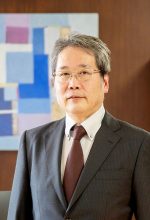
Greetings from President
Ryousuke KODAMA
I would like to take this opportunity to introduce myself as the new President of the Laser Society of Japan (LSJ).
First of all, I wish to express my sincere gratitude to the previous president, Dr. Kyuma, and all the past presidents, as well as to our members, who have led our society so strongly. With their efforts and cooperation, the society has made great strides in its development since its establishment in 1973. This year marks the 51st year since the Laser Society was founded, and the first year in which we will mark another 50 years beyond the new 50-year milestone. 50 years of history has been led by 10 presidents, and their outstanding leadership and vision have made the Society as strong as it is today. The Society has been able to establish itself as it is today thanks to the outstanding leadership and vision of these leaders. In particular, the contributions of our presidents, who have distinguished themselves in academia and made significant contributions in industry, stand out. With our 50 years of history as a background, we will continue to make further progress and development in the future.
Laser technology is a cutting-edge research tool as well as a state-of-the-art technology that is constantly advancing. For this reason, the application of laser technology is always undergoing new developments, leading to the opening up and expansion of new fields of application. Due to the high versatility and wide range of applications of laser technology, it plays an extremely important role not only in academia but also in industry.
As President, I intend to manage the Society with the spirit of ” timelessness and change” or the balance between tradition and innovation. The word ” timeless” refers to the importance of unchanging values, while “change” refers to the flexibility to adapt to the changing times and to actively adopt new approaches. As for the ” timeless,” we will continue to keep the strong point of our society, the collaboration between academia and industry, as our legacy, and as for the “change,” we will continue to take on new challenges in response to the changing times. I would like to promote the development and participation of the younger generation and achieve sustainable management of the society for the next 50 years. In addition, I hope to continue to be an academic society that contributes to society by developing new fields of application for laser technology and further deepening our collaboration with industry.
In the coming years, laser technology will become more diverse and more important. It is a pleasure to work with all of you to keep this wonderful technology alive for the future.
In closing, I would like to ask for your warm support and kind cooperation.
June 2024
Ryousuke KODAMA, President, The Laser Society of Japan
